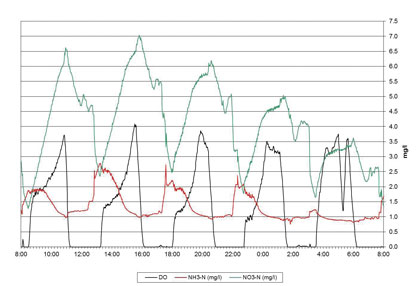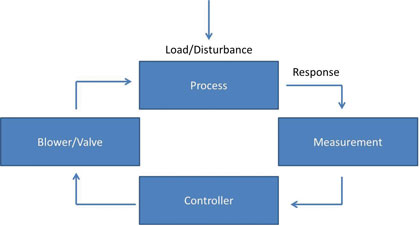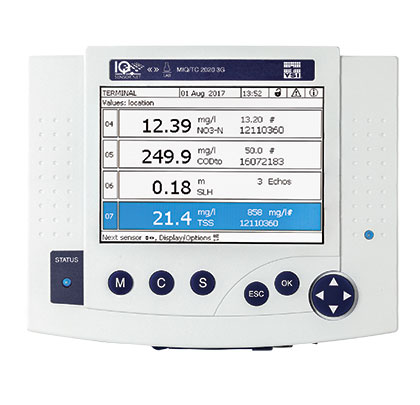In part 1 of this series, we introduced a broad view of the use of online instrumentation for control of wastewater treatment aeration, which, although once considered the weakest link of ICA, have become capable of measurements at a frequency, accuracy, and reliability suitable for process control at a reasonable cost thanks to the practically unlimited computing power found in most stations. In this month’s entry, we’ll take a closer look at open loop control, also known as sequencing, where control elements are turned on and off based on a timer and relays, and closed loop control, in which the process response is measured by online instrumentation and implemented in SCADA using PLCs and motorized variable actuators.
OPEN LOOP CONTROL (SEQUENCING)
The next level of control is open loop control, also known as sequencing, where control elements are turned on and off based on a timer and relays. The basic strategy does not utilize process measurements. Instead, predetermined cycle lengths are based on empirical design routines with additional modes for special situations like storm flows. The advantage is that the control system and the operation are simple. Blower operation will start and stop without operator attention. The drawback is that the system will operate inefficiently because it does not adapt to varying wastewater loads. A common application of this control strategy is a sequencing batch reactor (SBR) which cycles through stages of fill, react, and decant based on a timer. Figure 1 shows the operating cycle and response measurements in a typical SBR for one day.

Figure 1: SBR operating cycles for a one-day period
The inefficiency of the system is demonstrated by observing the trend in ammonium concentration (the red line) which indicates the extent of nitrification, and the DO concentration. The cycles are conservatively designed to ensure sufficient treatment. The ammonium concentration is an indicator of the extent of treatment because nitrification is the rate limiting step. DO spikes each cycle indicating that nitrification completes before the end of the cycle. When wastewater loads are high, the DO spike occurs towards the end of the aerated cycle. However, as wastewater loads decrease, the DO spike occurs earlier in the cycle. By the last cycle DO spikes immediately and the high concentration is carried through the end of the aerated period due to reduced oxygen demand. Maintaining elevated DO after nitrification is completed wastes energy. Turning off blowers after the ammonia concentration reaches a target level would save energy and increase the capacity for denitrification (nitrate concentration in green). Additionally, adjusting cycle time to match treatment requirements could increase treatment capacity allowing the utility to defer capital expense for construction of additional tanks and other infrastructure. Open loop control is simple and inexpensive to implement but will not be ideal. It is most suited to slow processes where disturbances are small and predictable, for example a package plant serving an institution such as a school or a limited number of households without substantial inflow and infiltration or industrial sources.
CLOSED LOOP CONTROL
Most wastewater treatment plants cannot be optimized using open loop control because wastewater characteristics vary quickly and sometimes unpredictably. Treatment must be provided for whatever comes down the pipe whenever it arrives. For this situation closed loop control is required in which the process response is measured by online instrumentation and implemented in SCADA using PLCs and motorized variable actuators. This is also called feedback control as depicted in Figure 2.

Figure 2: Feedback principle (source: Gustaf Olsson, Lund University, Sweden)
Changing wastewater loads result in a disturbance to the process which causes a response. The measurement is reported to a controller which reacts to eliminate the difference between the measurement and the desired setpoint, the error, by manipulating the control variable for an actuator on a valve or blower. Therefore, feedback control for aeration requires sensors to measure response variables, blower air flow control, basin air flow control, and a process control system.
Feedback control of aeration based on measurement of DO has been practiced for many years. However, calibration and routine maintenance required for traditional polarographic sensors was time consuming and costly and limited more widespread adoption into aeration control strategies. The introduction of optical DO measurement technology, based on luminescence, is a significant innovation. Optical DO sensors are extraordinarily stable and do not require calibration for the lifetime of the sensing element which is typically 1 to 2 years. Furthermore, there are no membranes to replace, electrodes to clean, or electrolyte solution to replace as with polarographic sensors.
The drawback to using DO as a response variable is that it does not provide information about the extent of reactions, e.g. nitrification or denitrification. The following examples show how measurements of complementary response variables in feedback control strategies can increase performance and efficiency.
Oxidation Reduction Potential (ORP)
ORP provides indication of the anoxic or anaerobic state of a reactor where DO concentrations are low or below detection limits as is required for biological removal of nitrate and phosphorus. For example, a slightly positive or negative ORP (-50 mV to +50 mV) indicates anoxic conditions for denitrification whereas a very negative ORP (<-100 mV) indicates anaerobic conditions suitable for phosphorus release. It is commonly used to determine the length of “off” stages in an on/off aeration control strategy for cyclic activated sludge or SBR systems.
Ammonium
The development of stable ammonium ISEs is a significant innovation. ISE sensors provide a direct, instantaneous measurement without the need for the sample preparation systems or reagents that are required for automated wet chemistry systems, also known as cabinet analyzers. Furthermore, the acquisition cost is approximately one third and the annual costs of operation are one-half that of cabinet-style analyzers. Ammonium ISE sensors allow operators to directly monitor the status of nitrification. Monitoring of nitrification is critical to energy conservation because the nitrification rate increases in proportion to the DO concentration up to approximately 1.5 mg/L. Above 2.0 mg/L, only marginal increases in the rate of nitrification are observed. Therefore, lower energy usage is achieved by maintaining a DO not higher than 2.0 mg/L when ammonia concentrations are high and reducing air supply to the minimum required for mixing after nitrification is complete.
Nitrate/Nitrite
Nitrate ISE technology is not new but there have been important innovations. Probes are now available with nitrate, ammonium, and compensation electrodes greatly increasing the accuracy and functionality of the instrument. Nitrate is used in place of ORP as a direct measure of denitrification to control aeration in cyclic activated sludge and SBRs. It is most useful for controlling sludge recirculation (RAS or IMLR) in BNR activated sludge.
Chemical Oxygen Demand (COD)
Measurement of COD is one of the most exciting developments in sensor technology, made possible by digital technology and ever smaller electronics. A COD sensor is basically a submersible spectrophotometer. Measurement of COD without wet chemistry is possible because most organic molecules absorb ultraviolet (UV) radiation. The raw measurements from a wide range of wavelengths over the UV and visible range can be used to calculate COD and compensate for interferences using statistical techniques. Measurement of influent COD combined with ammonium, allows for an accurate online oxygen demand prediction for feed forward control.
A LOOK AHEAD
In next month’s conclusion, we’ll examine the simplest form of feedback control, on-off control, as well as the efficiency benefits of a proportional-integral-derivative, or PID controller. We’ll then wrap up with a clear breakdown of cost benefits of greater control. υ
YSI’s environmental products provide high quality, high resolution data to better understand and manage our water resources. They are used for wastewater process control, climate change and drought studies, flood monitoring and warning, stormwater runoff monitoring, groundwater quantification and contamination, aquaculture production, and source water safety. For more information, visit www.ysi.com.
_______________________________________________________
MODERN PUMPING TODAY, December 2017
Did you enjoy this article?
Subscribe to the FREE Digital Edition of Modern Pumping Today Magazine!
![]()


